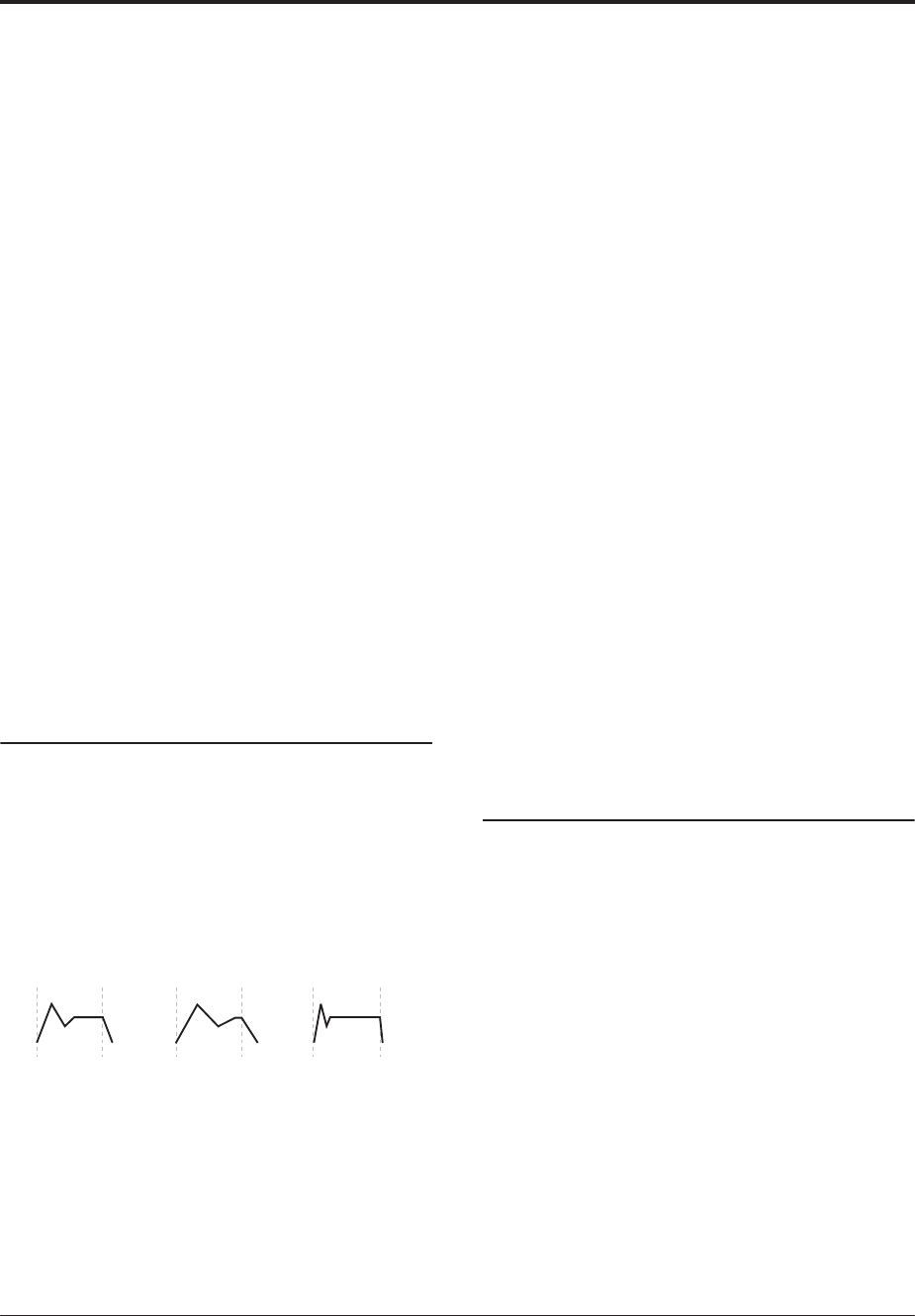
Program mode: HD-1
80
Once an EG segment begins, it can’t be modulated
Once the EG has started a segment between two
points, that segment can no longer be modulated. This
includes both the time of the segment, and the level
reached at the end of the segment.
For more information, see “Once an EG segment
begins, it can’t be modulated” on page 70.
AMS [List of AMS Sources]
This selects an AMS source to control the EG’s Level
parameters.
For a list of AMS sources, see “AMS (Alternate
Modulation Source) List” on page 967.
Start [–99…+99]
This controls the depth and direction of the AMS
modulation for the Start level.
For example, if you set the AMS source to Velocity and
set Start to +99, the Start level will increase as you play
harder. If you instead set Start to –99, the Start level
will decrease as you play harder.
Attack [–99…+99]
This controls the depth and direction of the AMS
modulation for the Attack level.
Break [–99…+99]
This controls the depth and direction of the AMS
modulation for the Break level.
4–3d: Time Modulation
These settings let you use three different AMS sources
to control the Time parameters of the EG. For each of
the three AMS sources, the Attack, Decay, Slope, and
Release times each have their own modulation
intensities.
Amp EG Time Modulation
AMS1 [List of AMS Sources]
Selects the first AMS source to control the EG’s Time
parameters. Velocity and Keyboard Track can both be
useful here, for instance.
For a list of AMS sources, see “AMS (Alternate
Modulation Source) List” on page 967.
Attack [–99…+99]
This controls the depth and direction of the AMS
modulation for the Attack time.
For example, if you set the AMS source to Velocity and
set Attack to +99, the Attack time will get much longer
at higher velocities. If you instead set Attack to –99, the
Attack time will get much shorter at higher velocities.
When the AMS source is at its maximum value–for
instance, when Velocity is at 127–a setting of +8 will
make the segment time almost twice as long, and a
setting of –8 will cut the segment time almost in half.
Decay [–99…+99]
This controls the depth and direction of the AMS
modulation for the Decay time.
Slope [–99…+99]
This controls the depth and direction of the AMS
modulation for the Slope time.
Release [–99…+99]
This controls the depth and direction of the AMS
modulation for the Release time.
AMS2 and AMS3
These select the second and third AMS sources,
respectively, for controlling the EG’s Time parameters.
Each has its own intensities for Attack, Decay, Slope,
and Release. The parameters of both AMS2 and AMS 3
are identical to those of AMS1, above.
▼ 4–3: Page Menu Commands
The number before each command shows its ENTER +
number-key shortcut. For more information on these
shortcuts, see “ENTER + 0-9: shortcuts for menu
commands” on page 138.
• 0: Write Program. For more information, see “Write
Program” on page 138.
• 1: Exclusive Solo. For more information, see
“Exclusive Solo” on page 138.
• 2: Copy Oscillator. For more information, see
“Copy Oscillator” on page 144.
• 3: Swap Oscillators. For more information, see
“Swap Oscillator” on page 144.
• 4: Sync Both EGs. For more information, see “Sync
Both EGs” on page 145.
4–5: Amp2/Driver2
This page controls Oscillator 2’s basic level, pan, and
driver settings. It is available only when the Oscillator
Mode is set to Double; if not, the page will be grayed
out.
The parameters are identical to those for Oscillator 1,
as described under “4–1: Amp1/Driver1,” on page 73.
Note-on Note-off Note-on Note-off Note-on Note-off
AMS=Velocity, Intensity = a positive (+) value
“Attack”= +, “Decay”= +,
“Slope”= +, “Release”= +
Softly played note.
Original Shape.
“Attack”= +, “Decay”= +,
“Slope”= +, “Release”= +
Strongly played note.
Times are longer.
Reaches Sustain
more slowly.
“Attack”=–, “Decay”=–,
“Slope”=–, “Release”=–
Strongly played note.
Times are shorter.
Reaches Sustain
more quickly.


















